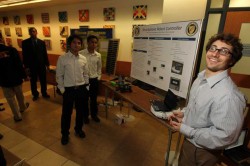Senior engineering students shared the results of their two-semester design courses with their clients and more than 100 visitors from the Vanderbilt community at Senior Design Day.
Engineering seniors have spent the academic year tackling design challenges from corporations. Sponsors this year include Nissan, Denso, Arnold Air Force Base, Lexmark, MAX Mobility, Roche Diagnostics, and several area engineering firms.
More than 70 projects by interdisciplinary teams in biomedical engineering, chemical and biomolecular engineering, civil engineering, electrical engineering and computer engineering, engineering management and mechanical engineering were displayed April 26 throughout the first floor of Featheringill Hall.
Projects included a football helmet and shoulder pad system to reduce head trauma. In recent years, football organizations and the media have been concerned about the risk of concussions during games, especially in light of evidence that they can lead to permanent brain damage. Bleeding in the brain has received less attention.
The helmet system project adviser and a resident in neurosurgery at Vanderbilt University, Jonathan A. Forbes, is the lead author of a new report that suggests that researchers should explore ways to redesign football helmets to reduce the risk of brain hemorrhage after a collision.
Since 1945, more than 350 football players wearing helmets have died of bleeding in the brain after collisions, according to the report. Forbes said the research findings suggest that “it’s worth taking a new look at the safety of helmets.”
Senior Tyler Severance said their helmet model has received “really positive” feedback from experts. “It’s something we’re very proud of,” said Severance, a biomedical engineering major. Other project members are BME major Jeffrey Markle and mechanical engineering major Douglas Browne.
The helmet-shoulder pad system involves spring loaded rotators connected to a modified butterfly collar in three spots – one on each side and in the back. The athlete can still move his head in all directions but will encounter resistance if the range of motion is too great or the impact velocity is too high.
Also, the device uses an accelerometer to indicate when an athlete has undergone a severe collision and should receive medical attention.
“All that remains is to return to the lab and test it under ideal testing conditions where acceleration points can be monitored effectively. Additionally, we have basic programming that simulates collisions in football, and are working to simulate the same collisions with our new design,” Severance said.
Other projects included robotic ‘triage interactive nurse assistant’ (TINA) sponsored by Vanderbilt Department of Emergency Medicine. Although this is an electrical engineering and computer science project, the team includes biomedical and mechanical engineering seniors.
The team designed a device that combines a touch screen monitor, a blood pressure cuff, a pulse oximeter and a scale. Through a graphical user interface created by the team, a patient would answer typical personal and medical history questions. The patient’s blood pressure, weight, oxygen saturation and pulse would be read by the integrated devices and the computer’s camera would allow the patient to be visibly monitored.
A civil engineering senior design project with local interest is a Metro-Nashville traffic safety study sponsored by RPM Transportation Consultants. The student design team evaluated four intersections with known safety concerns: 20th Avenue and Terrace Place, 21st Avenue and Church Street, Church Street and 18th Avenue, 21st Avenue and Acklen Avenue. The team will write a technical memorandum outlining the results of crash analyses, conclusions and recommendations for each intersection.
The work done in senior design is the intellectual property of the participating companies, which means legal negotiations are unnecessary. This allows collaboration with participating companies and students gain real-world experience.
Teams met with their clients to define the challenge, create a strategy, build a timeline, assign responsibilities, set deadlines and manage customer relations.
Students usually get to work on a project they prefer. “Occasionally, some get drafted,” says Joel Barnett, associate professor of mechanical engineering and senior design faculty adviser. “If they end up working on something they don’t like at first or are unfamiliar with, well, we say, ‘Welcome to the real world of work.’
“These projects often turn out to be some of the best, since the team is working in areas that are new to them,” he said.
Other 2010-2011 faculty advisers are Bob Webster, mechanical engineering; Paul King, biomedical engineering; Ken Debelak, chemical and biomolecular engineering; Sanjiv Gokhale, civil engineering; Jeffrey Black, electrical and computer engineering; and John Bers, engineering management.
